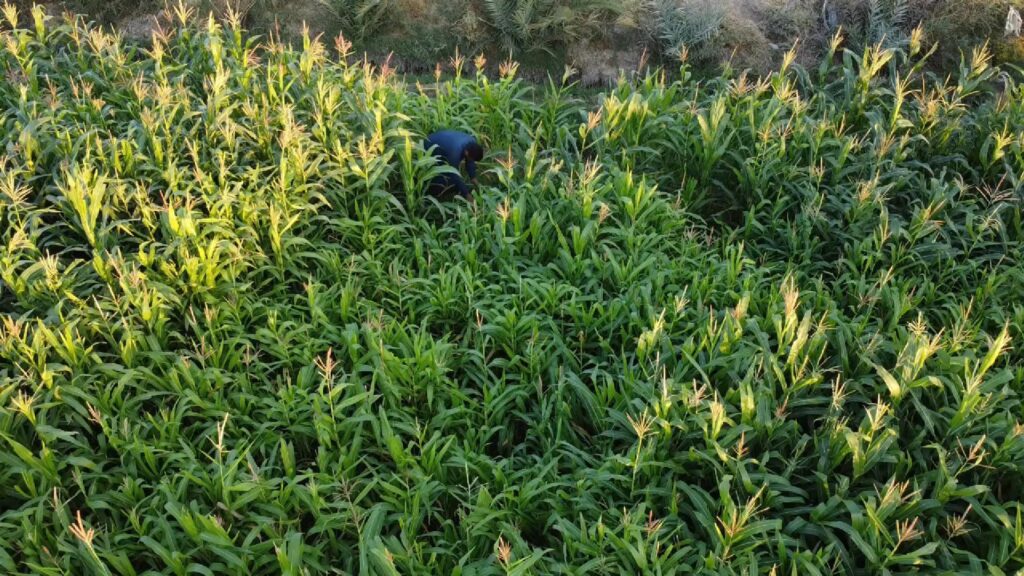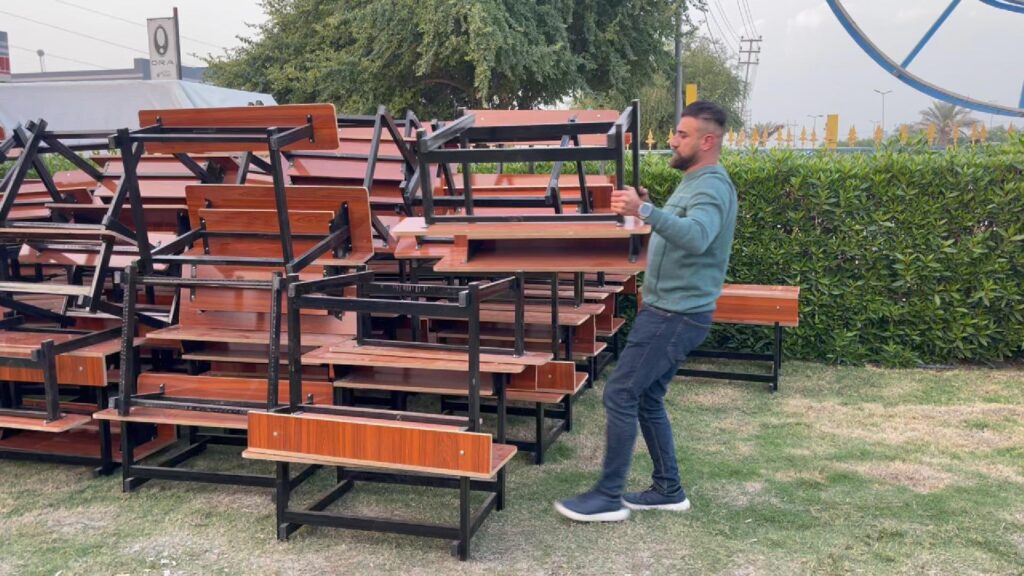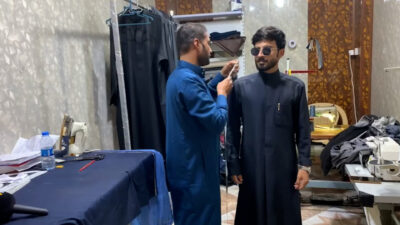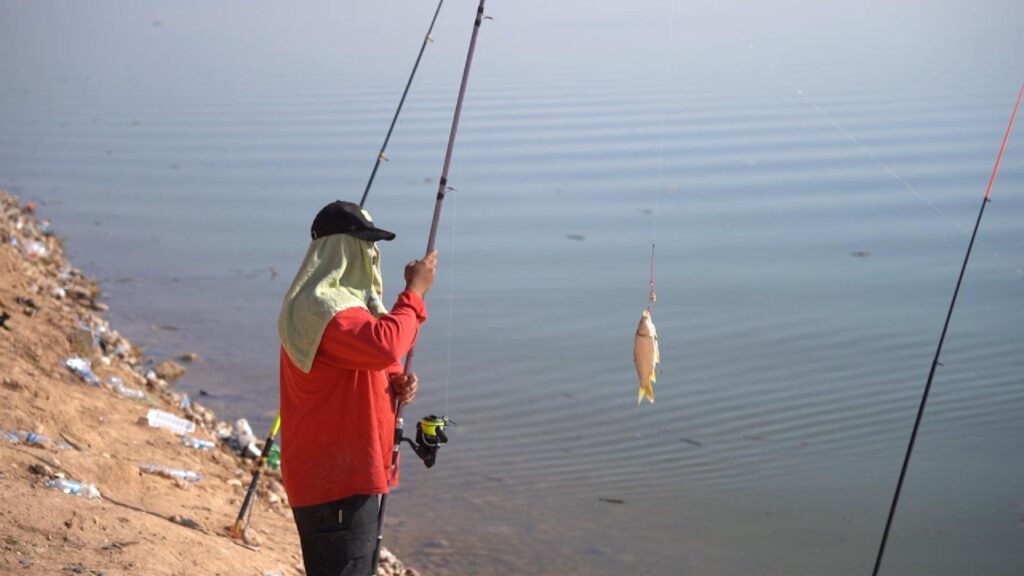War, insurgency, IS and instability: Iraq since the 2003 US invasion

A TV graphic showing the final US Senate vote result in October 2002.
October
The US Congress votes overwhelmingly to authorise President George W Bush to use force against Iraq after the Bush administration argues that Iraq’s weapons of mass destruction pose an immediate threat to US and global security.
US Marines kneel and pray as the 2nd Battalion, 8th Regiment prepares to leave Camp Shoup, north of Kuwait City, in a northbound direction to start their advance into southern Iraq, 20 March.
February
The US secretary of state, Colin Powell, seeks international backing for military action against Iraq in a presentation before the UN security council, using satellite photos and communications intercepts to try to show Iraq’s deceptions over weapons of mass destruction.
March
US-led forces invade Iraq from Kuwait to oust Saddam Hussein. The effort crushes the Iraqi military and chases Saddam from power in a span of weeks.
US army soldiers from A Company, 3rd Battalion, 7th Infantry Regiment search a presidential palace in Baghdad, Iraq on 8 April 2003.
April
US troops seize Baghdad. Saddam goes into hiding. Lawlessness quickly emerges in Iraq’s capital and elsewhere, with US troops failing to bring order.
May
President Bush declares that “major combat operations in Iraq have ended” and that “in the battle of Iraq, the United States and our allies have prevailed.” As he speaks aboard an aircraft carrier a banner behind him states, “Mission Accomplished.”
President George W Bush meets crew members on the deck of the aircraft carrier USS Abraham Lincoln on 1 May 2003.
Summer
An insurgency arises to fight US-led forces. US forces fail to find weapons of mass destruction.
Saddam Hussein sits on a couch shortly after his capture by US forces in a farm house outside Tikrit, Iraq, 14 December 2003.
December
US troops capture Saddam hiding in a hole near Tikrit.
Former top weapons inspector David Kay prepares to testify on Capitol Hill on 28 January 2004, before the Senate armed services committee hearing on Iraqi weapons of mass destruction.
January
Top US weapons inspector David Kay acknowledges to Congress that “we were almost all wrong” about Iraq’s weapons of mass destruction.
Marines with Fox Company, 2nd Battalion, 1st Marine Regiment, head into Falluja, Iraq on 6 April 2004.
Spring
The insurgency intensifies, with violence in Falluja and elsewhere in the mainly Sunni Muslim Anbar province as well as violence by followers of Shia cleric Moqtada al-Sadr in major Shia cities in the south. The US faces international condemnation after photographs emerge showing abuse of detainees at the Abu Ghraib jail.
A member of the Iraqi National Guard stands near villagers queueing to vote for the national polls in a polling precinct in Al Anbar province, 243 kilometres west of Baghdad, Iraq on 30 January 2005.
January
Millions vote in the first multiparty elections for 50 years. A series of attacks across the country kill at least 36 people.
April
Jalal Talabani, a Kurdish politician and former guerrilla leader, is sworn in as president of Iraq.
September
Lynndie England, a US private who was pictured holding a naked Iraqi prisoner on a leash at Abu Ghraib, is sentenced to three years in jail by a military court.
US Army PFC Lynndie England arrives for a court martial hearing at the judicial centre at Fort Hood, Texas, US on 2 May 2005.
Iraqis walk past the damaged al-Askari shrine after an explosion in Samarra, north of Baghdad, Iraq in February 2006.
February
The bombing of a Shia shrine in Samarra sparks widespread sectarian slaughter, raising fears of civil war between Shia and Sunni Muslims.
April
Shia politician Nouri al-Maliki is asked to lead postwar Iraq’s first full-term government as prime minister.
A US soldier stands next to the picture of the dead al-Qaida leader in Iraq Abu Musab al-Zarqawi during a news conference at the fortified Green Zone in Baghdad, Iraq on 8 June 2006.
June
The al-Qaida leader Abu Musab al-Zarqawi is killed in a US airstrike near Baquba. He had a $25m bounty on his head.
December
Saddam is executed at the Khadamiyah intelligence centre in Baghdad. Mobile phone footage emerges of him being taunted at the gallows.
An Iraqi soldier videotapes the ruins of a coordinated suicide attack in the town of Qahataniya, 75 miles west of Mosul, Iraq, on 15 August 2007.
August
More than 400 people are killed as four suicide bombers detonate cars in two villages occupied by Yazidi Kurds in northern Iraq.
September
Guards from the US private security contractor Blackwater are accused of opening fire on civilians in Baghdad, killing 17.
A convoy of armoured personnel carriers holding British forces returning to the contingency operating base after the handover of Basra Palace to the Iraqi Palace Protection Force on 3 September 2007.
December
British forces formally hand over control of Basra to the Iraqi government in a move paving the way for a major reduction in the number of British troops in Iraq.
Turkish tanks cross into northern Iraq from the Habur border near Turkey’s southeastern city of Diyarbakir, 22 February 2008.
February
Thousands of Turkish troops are sent across the border into northern Iraq in a major ground offensive against the Kurdish PKK rebel forces.
Cleaners sweep the site of a bombing in Baghdad’s central district of Karrada on 7 March 2008. Two bombs went off within minutes of each other in Karrada’s crowded shopping district, killing at least 53 people and wounding 130.
March
A roadside bomb, followed by a suicide bomb, kills 68 people at a busy shopping area in the centre of Baghdad, the second deadliest attack of the year thus far.
November
Iraq and the US sign an accord requiring Washington to withdraw its forces by the end of 2011.
US president Barack Obama greets troops at Camp Victory in Baghdad on 7 April 2009.
March
The newly inaugurated US president, Barack Obama, announces the withdrawal of 12,000 US troops by the end of August 2010. Up to 50,000 will stay on until the end of 2011 to advise Iraqi forces and protect US interests.
April
Britain officially ends combat operations in southern Iraq, handing over control of its base in Basra to US forces.
June
US troops withdraw from Iraqi cities, leaving Iraqi forces in control of security.
July
The first independent inquiry into the Iraq war, chaired by Sir John Chilcot, opens in London.
2010
January
Ali Hassan al-Majid, better known as Chemical Ali, is executed for crimes against humanity in Iraq’s highest profile execution since Saddam’s hanging.
May
Former prime minister Ayad Allawi is the surprise winner of parliamentary elections, but his 91 seats are insufficient to form a government.
US soldiers of the 1st Battalion, 116th Infantry Regiment, wait to load their luggage as they prepare to pull out from Iraq and leave for Kuwait from Tallil airbase near Nasiriya, 220 miles southeast of Baghdad, on 15 August 2010.
August
Iraq’s two main political blocs suspend talks on forming a government. The last US combat troops leave Iraq.
A US soldier inspects preparations for the last US convoy to leave Iraq from Camp Adder on the outskirts of the southern Iraqi city of Nasiriyah in 2011.
December
US troops complete their withdrawal. Iraq issues an arrest warrant for Sunni vice-president Tariq al-Hashimi on anti-terror charges, sparking a political crisis.
Iraqi Sunni protesters hold up a portrait of prime minister Nouri al-Maliki with slogans reading in Arabic, “liar … sectarian, thief, collaborator” during a protest against him on the main highway to Syria and Jordan near Ramadi, Anbar’s provincial capital west of Baghdad, on 4 January 2012.
December
Major protests start, particularly in the Sunni province of Anbar, demanding Maliki’s departure.
Residents carry a coffin during the funeral of an Iraqi soldier in Baghdad on 25 April 2013.
April
Clashes in Hawija in northern Iraq between security forces and anti-government protesters allegedly infiltrated by militants kill more than 240 people in a week.
August
More than 70 people are killed in attacks at the end of Ramadan, claimed by the powerful jihadi Islamic State of Iraq and the Levant, a group that becomes known as Islamic State and then IS.
Masked Sunni gunmen chant slogans during a protest against Iraq’s Shia-led government, demanding that the Iraqi army not try to enter the city, in Falluja, 31 miles west of Baghdad, on 7 January 2014.
January
Iraq loses control of Falluja and parts of Ramadi in Anbar province to al-Qaida-linked fighters after security forces cleared an anti-government protest camp. The UN estimates nearly 500,000 Iraqis flee the fighting in subsequent months.
April
Maliki wins the most seats in the first general election since US troops departed, but his State of Law alliance falls short of an overall majority.
A fighter of the Islamic State of Iraq and the Levant (ISIL) holds an ISIL flag and a weapon on a street in the city of Mosul, Iraq, on 23 June 2014.
June - September
Sunni rebels led by IS surge out of Anbar province to seize Iraq’s second city of Mosul and other key towns. Tens of thousands flee amid atrocities. Kurdish forces, the US and Iran assist the government in repelling attacks.
September
Shia politician Haider al-Abadi forms a broad-based government including Sunni Arabs and Kurds. The Kurdish leadership agrees to put an independence referendum on hold.
A militant hammers away at a face on a wall in Hatra, April 2015.
March
IS destroys the Assyrian archaeological sites of Nimrud and Hatra.
April
Government forces reoccupy Tikrit and drive out IS after a month-long siege.
May
IS captures Ramadi, the capital of the western province of Anbar, in a lightning assault.
August
Parliament approves reforms to cut corruption and sectarian government job quotas after riots against frequent power cuts.
December
Government forces recapture central Ramadi.
Iraqi military vehicles and troops advancing towards the centre of Al Muhammadi district, west of Ramadi city, western Iraq on 18 March 2016.
February
Government troops expel last remaining IS fighters from the Ramadi area. Shia cleric Moqtada al-Sadr leads a mass demonstration in Baghdad in protest at government corruption and the slow rate of progress in delivering on promised reforms.
April
Supporters of Sadr storm a parliament building demanding a new government to fight corruption and end the allocation of government posts along sectarian lines.
Iraqi soldiers gesture in centre of Falluja, Iraq on 17 June 2016.
June
Iraqi forces retake Falluja from IS. The city is destroyed and deserted, with burnt-out cars and debris.
October
Abadi announces the start of the operation to liberate Mosul.
Iraqi soldiers shooting at IS fighters hiding behind a berm in the Old City of Mosul in November 2017.
June
Iraqi forces launch battle for Mosul’s Old City, the last IS stronghold there. IS destroys Mosul’s iconic al-Nuri Mosque and its 12th century leaning minaret as Iraqi forces close in.
July
Abadi victory over IS in Mosul and end of the extremists’ caliphate in Iraq.
December
Abadi declares victory over the Islamic State.
May
Political bloc led by Sadr wins parliamentary elections. After a recount, results are finalised in August.
July
Widespread unrest sweeps across the oil-rich Shia heartland of southern Iraq, as protesters vent their anger over electricity cuts, poor services and unemployment amid post-election uncertainty.
September
Protesters storm the Iranian consulate in Basra as demonstrations turn deadly.
October
Iraq’s newly named president, Barham Salih, chooses the independent Shia politician Adel Abdul-Mahdi to be the next prime minister and form a government.
October
Mass protests spread to Baghdad, as demonstrators’ demands evolve from initial calls for employment and better services to the fall of the government. Scores are killed and thousands injured.






